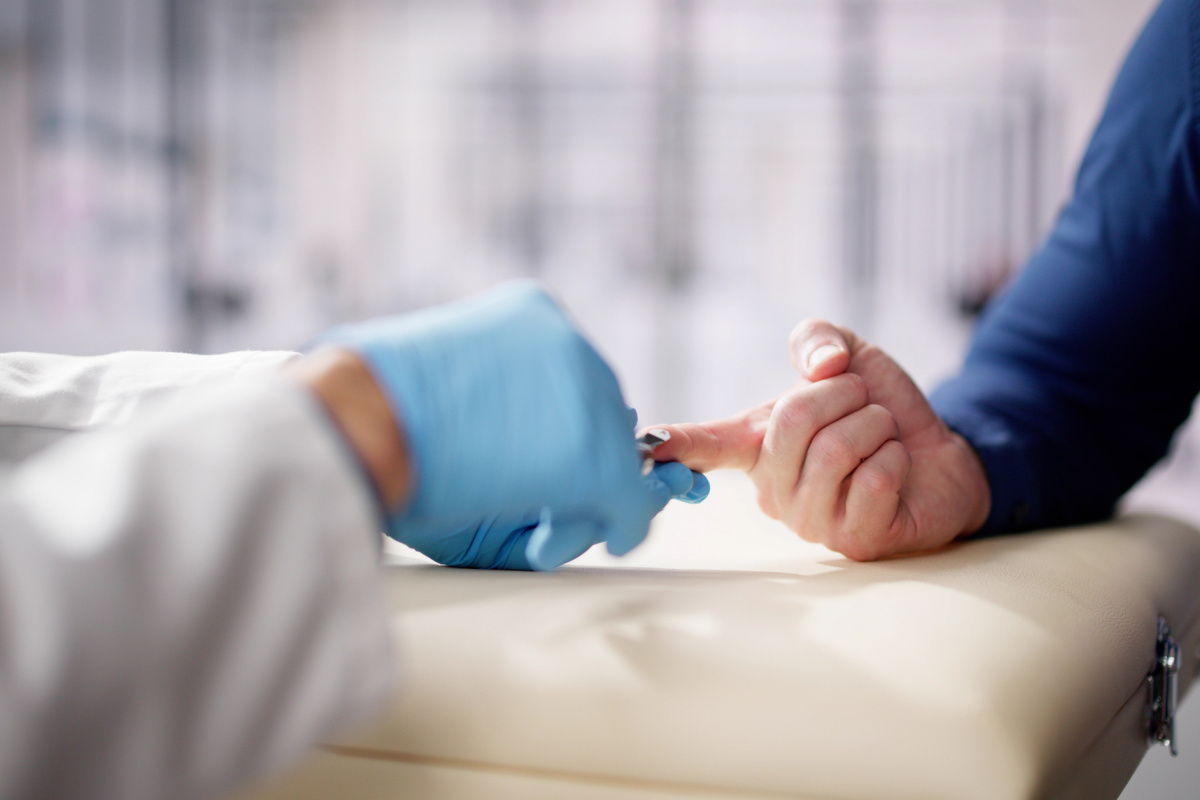Physicians are humans. Like humans, some subset of the doctor population drinks to excess, impairing function. Most doctors who drink alcohol are not in this subset. They drank sparingly, in moderation, and/or socially.
If function is impaired, then arguably patients are put at risk. So, hospitals, healthcare organizations, and licensing boards have a legitimate interest in making sure physicians are not impaired.
If there is a reasonable suspicion that function is impaired, then “on-the-spot” testing can help decipher. If a driver is weaving wildly between lanes and cannot walk a straight line, then the officer will ask for a Breathalyzer test.
This same “on-the-spot testing” is performed at large healthcare institutions in select circumstances. As but one example, Human Resources at Duke notes: “Intervention” is mandatory if “Impairment” is suspected.
What is “Impairment?”
The supervisor is responsible for taking appropriate action when there is reasonable cause to suspect a staff member demonstrates impairment.
Impairment is defined as the effect of the use of alcohol or any psychoactive or mood-altering substance on mental, emotional and/or physical functioning. Symptoms may include, but are not limited to, drowsiness and/or sleepiness, odor of alcohol on breath, slurred/incoherent speech, unusually aggressive or bizarre behavior, unexplained change in mood, lack of manual dexterity, lack of coordination in walking, and unexplained work related accident or injury….
Falls, slips or injuries could be an indication of impairment.
The Policy goes on to recommend documenting the impairment via a checklist.
Then, the Supervisor
- Should MEET the staff member in private about the observed behavior and tell the staff member that in the supervisor’s judgment he/she appears impaired.
- Should not allow the staff member to continue to work or return to work until cleared by Employee Occupational Health and Wellness (EOHW) or designated facilities and should DIRECT the staff member as soon as possible to EOHW or the designated facility for assessment.
- Should CONTACT Staff and Labor Relations if the staff member is not cleared to return to work.
An assessment of the health status of a staff member will be conducted by EOHW in those situations which constitute reasonable cause. The assessment will include historical and physical examination information. Laboratory assessment may include evaluation of body fluids for substances including illegal drugs. The data will be analyzed based on customary medical criteria. Assessment for illegal drugs and alcohol will be based on federal and state agency guidelines.
Staff who refuse to be assessed will not be allowed to return to work until cleared by EOHW. Refusal to be assessed is considered a violation of the Drug and Alcohol Free Workplace Policy. Refusal to be assessed or to follow recommendations for rehabilitation once it is determined a substance use disorder exists may be grounds for termination.
A surgeon blood alcohol level of 0.25% measured soon after an unexpected patient complication is relevant to identifying whether the surgeon may represent a danger.
Doctors are often referred to Physician Health Programs (PHP) for further diagnostics. And doctors may be referred from PHP to alcohol / substance disorder centers for longer evaluations (3 days). And potentially referred from there for inpatient rehab lasting months – with follow-up monitoring lasting for years. Frequently, the doctor will have to pay out of pocket. Being out of work and paying for such interventions drains resources quickly.
Of course, if a physician is truly suffering from florid alcohol use disorder, intervention can be lifesaving.
Those struggling with alcohol use disorder frequently deny there’s any problem until they receive a push from ”one of the 4 L’s.” Their liver, their livelihood, their lover, or the law.
With this as backdrop, sometimes physicians are referred to such programs based on scant evidence. And their problems start to mushroom. Alcohol on the breath might represent gargling with mouthwash after brushing one’s teeth.
Physicians frequently will go along to get along. If they’ve done nothing wrong, what do they have to fear?
Introducing the PEth test. PEth is short for phosphatidylethanol.
Phosphatidylethanol (PEth) is a direct metabolite that is formed only in the presence of alcohol (and is thus highly specific). PEth is detectable for 3–4 weeks after repeated heavy alcohol consumption (defined as >60 g/day, on average), and has a half-life of 4–10 days (Hahn et al., 2016a, Helander et al., 2019a). It is also detectable after a single drinking session for 3–12 days (Schrock et al., 2016). PEth is measured from whole blood or dried blood spots (DBS) and is most frequently analyzed using liquid chromatography with tandem mass spectrometry (LC-MS/MS) (Jones et al., 2011).
The PEth metabolite lingers after drinking. If function was impaired by a bout of drinking, the PEth metabolite will remain well after sobriety and function have returned.
HR Departments and PHP Programs may ask for PEth testing after a reasonable suspicion of impairment. That test will likely be performed long after any alcohol, if present in the blood, is gone.
PEth may be useful for determining adherence to sobriety (meaning, no drinking).
But its use for determining alcohol use disorder is controversial. If a doctor drinks socially, what is that reference range? If a doctor drinks a glass of wine every night, what is that reference range? If a doctor goes camping with his friends out in the woods and has 8 beers during a single evening, but is otherwise “sober”, what is that reference range?
One article noted PEth sensitivity is still a work in progress.
Among people reporting unhealthy alcohol use, several biological factors (hemoglobin, BMI, liver fibrosis, and HIV status) were associated with PEth sensitivity. Race/ethnicity was associated with PEth sensitivity in some models; age, sex and method of blood collection were not. Clinicians should be aware of these factors, and researchers should consider adjusting analyses for these characteristics where possible.
There are other criticisms:
“The half-life of PEth has been reported to range between 4-12 days. The longer half-life of PEth could conceivably lead, in some individuals, to accumulation of PEth to significant levels from one or more sources of extraneous exposure to ethanol.”
“When asked about false positive blood PEth tests, some experts have opined that “there has never been a confirmed false positive.” However, there have been a number of studies where groups of individuals were tested and among them were those who claimed that they had not consumed alcoholic beverages but who did test positive.1 2 Experts have opined that these subjects were likely being dishonest, falsely claiming they had not been drinking, resulting in the positive tests. In fact, there is no way to know, from the available information, if the subjects were being dishonest or not. Some, or all, of these positive tests could have been false positives.”
“A study attempted to correlate PEth levels (16:0/18.1 and 16:0/18.2) with a cutoff of 10ng/ml in 300 light social drinkers to their reported ethanol use and AUDIT-C scores.9 Only 12 subjects (4%) reported total abstinence and all were negative for blood PEth. Further analysis plotting the Receiver Operating Characteristic (ROC) curve estimated a specificity for PEth of 96.6%. If this is even close to accurate, it suggests that a small portion of individuals may have false positive readings. The authors suggest that “relevant amounts of hidden alcohol in nutrition or medication as well as inter-individual variations of enzyme activities for the formation of PEth might cause unexpected elevated concentration levels of PEth.” Even if the PEth test is 99% specific for alcoholic beverage consumption, that still means that 1 out of every 100 tests could be falsely positive. Additionally, the authors of this study determined that a blood PEth level of <112ng/ml corresponded statistically to what they called moderate drinking based on the Audit C scores (which correlated to less than an average of 10gm/d of alcohol or less than 1 standard drink per day).”3
Is PEth useful in any context? Probably. But it’s limited to those with a clear diagnosis and in treatment.
PEth is a useful outcome measure that can be used to validate subjective reports of current drinking. In a treatment setting aimed at controlled drinking, the accuracy of patients’ self-report measures seems to improve over time. In this context, a PEth value of≥0.22 μmol/l is a sensitive and specific indicator of hazardous drinking.
As a generic screening tool, PEth is likely prone to misinterpretation. Given how high the stakes could be for a physician falsely labeled with alcohol use disorder, physicians should be cautious about casually “going along to get along” when asked to do a screening PEth test.
What do you think?






Physician nailed for this one via PRN Brian Gadbois MD. After a weekend of free cocktails at a local restaurant by manager, a one time binge. Multiple PETH tests after original test ALL zero. Had license restricted for 2 1/2 years with a plethora of tests all negative for all illegal substances, both for employment and post accusations by Brian Gadbois MD. Finally got license unrestricted, when a fellow PRN evaluator didn’t find any issue with tests and history. PRN might be good for some, but false allegations, fictious diagnoses,and misinterpretation of findings can destroy innocent victims. PRN, needs real oversite by non affiliated evaluators. What they do to innocent victims is criminal, extortion via state, malpractice and unjust enrichment. Attorneys and victims need to shut down this abuse. Along with the few honest evaluators. Like most things, follow the money. Addiction clinics need the infusion of this cash money, to make their business profitable, since so many true addicted people are broke, killing whales like physicians is great business. Very expensive out of pocket payments. Followed by years, if not life time of evaluation/expenses. The truly impaired pay the money and back to work in 3 months (that’s a problem) the innocent that fight suffer personal, professional and economic destruction. How many innocent victims pay the extortion, blackmail and unjust enrichment to save their reputation, livelihood and avoid being destroyed?
“SHOW ME THE MONEY”
You have articulated very well how institutions can weaponize these testing profiles of psychological testing and drug abuse suspicion to suppress open, transparent dialogue. Unfortunately, I have a personal experience with governmental bureaucrats trying to salvage their reputation/careers that put me in the cross fire. After years of legal battles, significant stress, and a settlement later, I can say that there is more than meets the eye with most of these testing. I encourage physicians to take careers back into their own hands and not become a w2 employee or 1099 contractor to a conglomerate that is not necessarily aligned with patient safety and outcomes.
From a human capital perspective, doctors are expendable to hospital organizations, that only care about profits and institutional malpractice safety. If the conglomerate (corporate or private) mess up, then they have an army of resources to help mitigate the damage to the organization. Therefore, I encourage private ownership where an elevated culture can be curated that exceeds these draconian policies that can destroy lives without any chance to rebuke circumstantial evidence. firmly believe that if we take care of the patient, then money and respect will follow. I am living that and the bank account agrees.
This test like all other tests put in the wrong hands can be abused.
Is there a blinded controlled study demonstrating that this test is infallible, in a large enough population group to have statistical power? Unknown but doubtful.
The problem is that these tests when used against physicians can be a process of sham peer review.
A physician that is a target, that is seen out having a glass of wine at dinner, could be tested with the hope of finding something incriminating.
A physician that I heard about decades ago, was known to consume bottles of wine, with his friend sand spouse, during a weekend. From what I heard he never showed up impaired. Would such a test have been used to impugn his reputation? Likely not since he was friendly with management. But in the exact same scenario a physician that was not friendly with management could be targeted by the misuse of this test.
As John describes, a second test that was negative should have cleared the physician.
There is also no question that there is an industry that has been created to “treat” “impaired” physicians, at their own expense running into the thousands of dollars, while the physician is unable to work. Can’t afford the treatment? The physician will be out of practice, permanently suspended by the medical licensure board.
The presumption of innocent until proven guilty by a jury of one’s peers, doesn’t apply to physicians.
100% correct. The case I am familiar with, is pure malpractice, fake diagnoses, extortion. and they buttressed their opinions, with incorrect demographics, clear misrepresentation of well known facts. It’s criminal DO GOODERS justify their EVIL work with good intentions. They should be held accountable like all of us for malpractice and criminal intent!
But, instead the victim has to first correct the injustice, before correcting the system. That takes time, money and loss of ability to work! There is no just compensation for the Evil done to innocent victims. Though there are a few reports of victims winning legal battles. People who ran these programs nation wide have reported the ABUSE of power and are speaking out for victims. There has to be outside overview of these programs, with true rapid due process!
It’s nice, others are aware of the abuse innocent physicians are going through. The example above was weaponized by another physician and no due process was given prior to the execution of a corrupt program.
“…Experts have opined….”
And who opined that they’re experts? What qualified them?
The simple experiment to do is to hire maybe 100 undergrads. Have a quarter of them drink to a specified blood alcohol level, a quarter of them drink to a higher level, and hold abstain. Total duration of study is 3 weeks. Measure PEth every 48 hours. Look for false positives and false negatives.
Has something like this been done? If not, it’s not science.
Jeff, I conducted research to determine if a false positive was possible, as today proponents of this test say that is not. I proved that it was. No alcohol. Same blood, five samples, 4 tests for PEth (five spots each strip) and one whole blood. Two of the four PEth tests (10 of the 20 spots) indicated heavy drinking and the other two tests identified nothing. This non-FDA test is invalid, and should be prohibited. It’s destroying lives. Petitt, Karlene (2024), “PEth Testing False Positives”, Mendeley Data, V1, doi: 10.17632/fg3r3gf7rj.1
Thanks for sharing that link!
There are two different methods for measuring PEth in the bloodstream. USDTL (United States Drug Testing Lab) uses Dried Blood Spot Analysis. This method requires a thin droplet of whole blood do be evenly spread evenly over a special blotting paper once only. Applying more than one layer can result in false positives.The blood needs to be promptly air dried in a protective container to avoid contamination and autofermentation which could result in a false positive test. Since no other labs use DBS, the donor cannot contest a false positive by sending the specimen to another lab. Quest Diagnostics uses whole blood for GS/MS analysis. This method comports with CLIA regulations but PEth testing is not FDA-approved for screening for alcohol consumption/abstinence because there are many as yet unknown variables affecting the half-life of PEth and potential factors which could confound testing. The only way to confirm a true negative is to do simultaneous blood alcohol and EtG and ETS testing and hair analysis in conjunction with behavioral observation. SAHMSA does not approve its use for workplace drug testing and advises that PEth should NEVER be used to determine alcohol relapse without clinical correlation and confirmatory testing. The object of any safety program should be safe and reliable performance of one’s job duties not abstinence or negative testing.